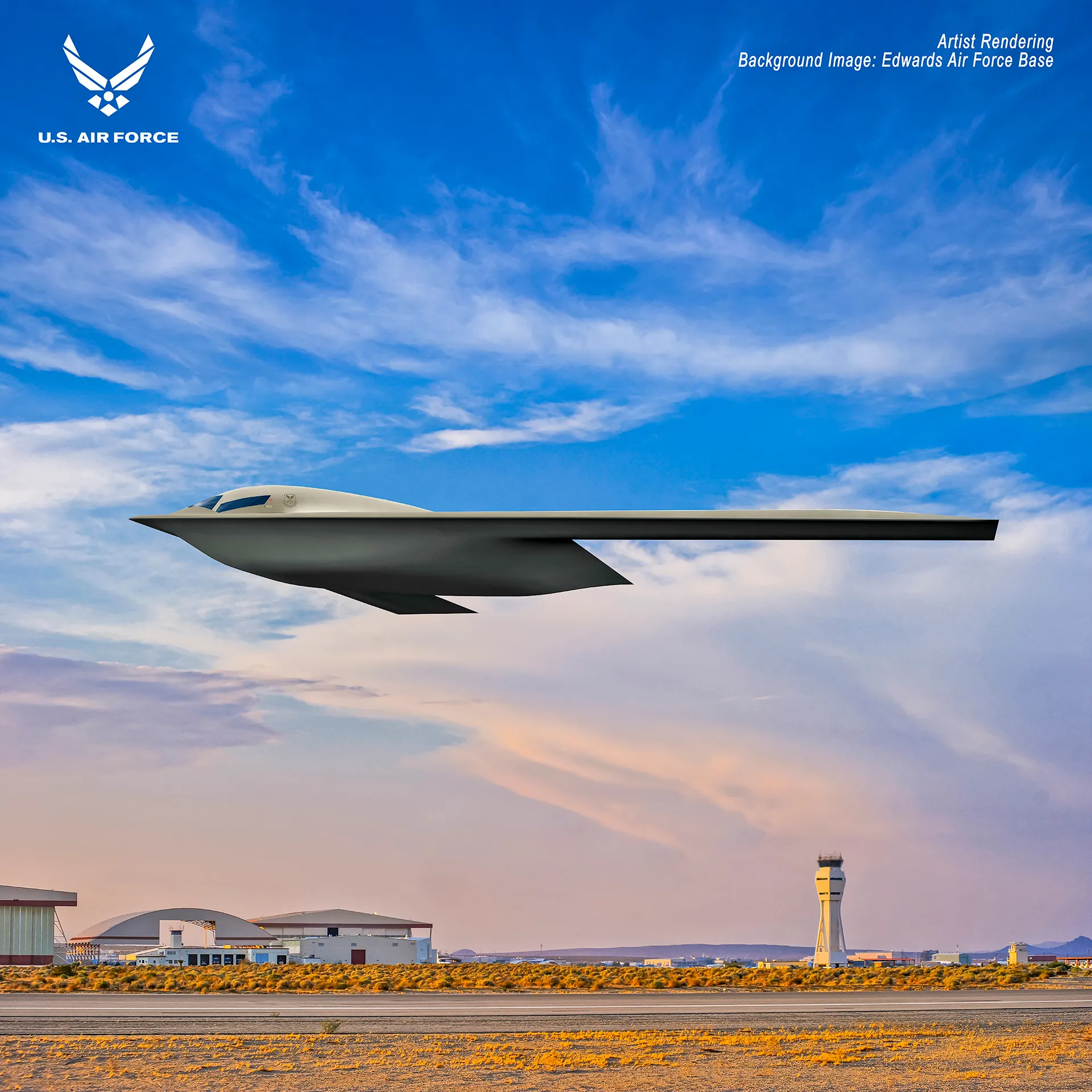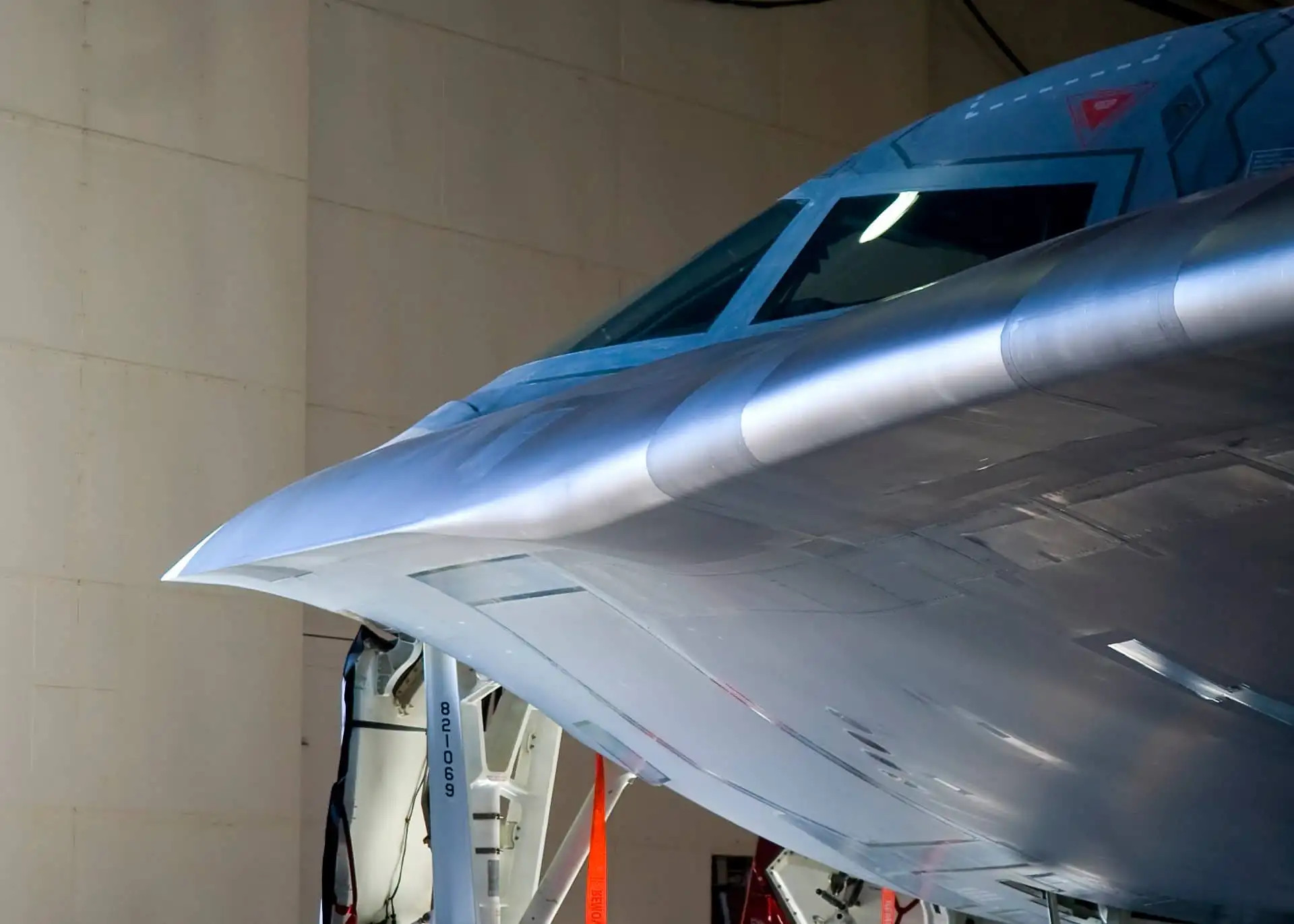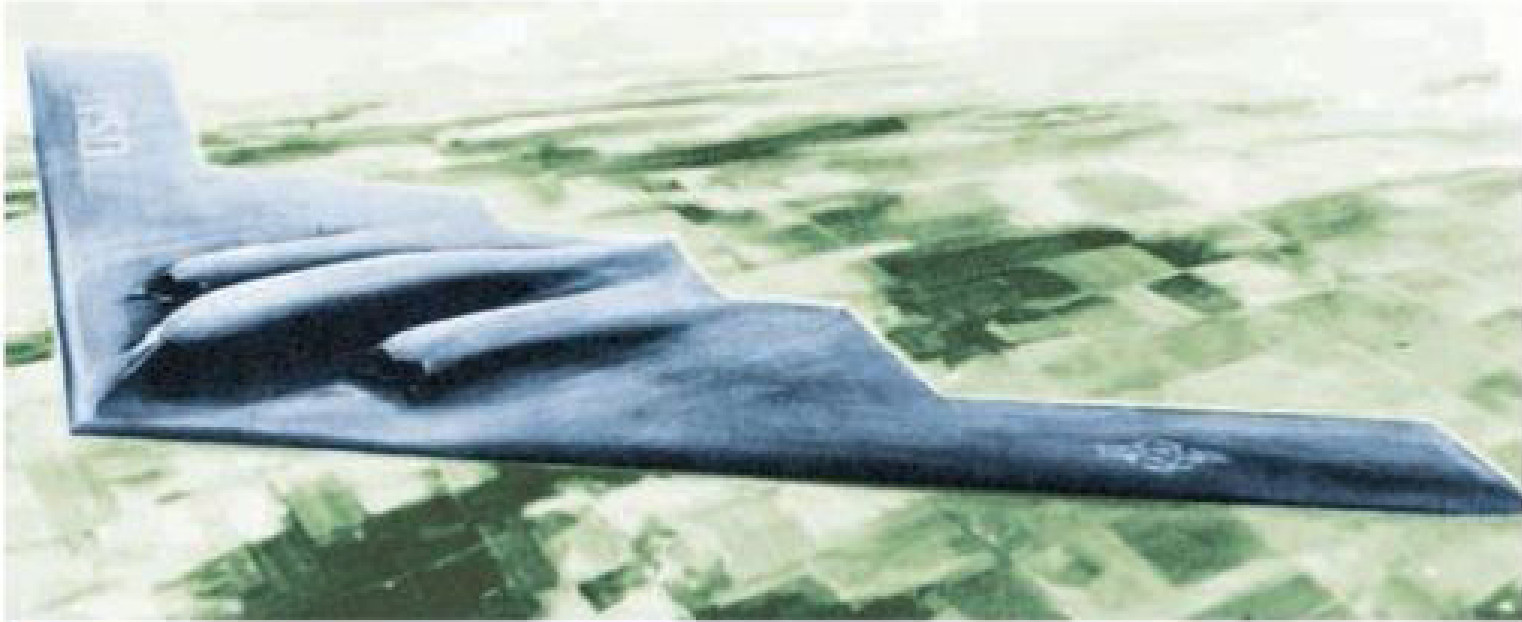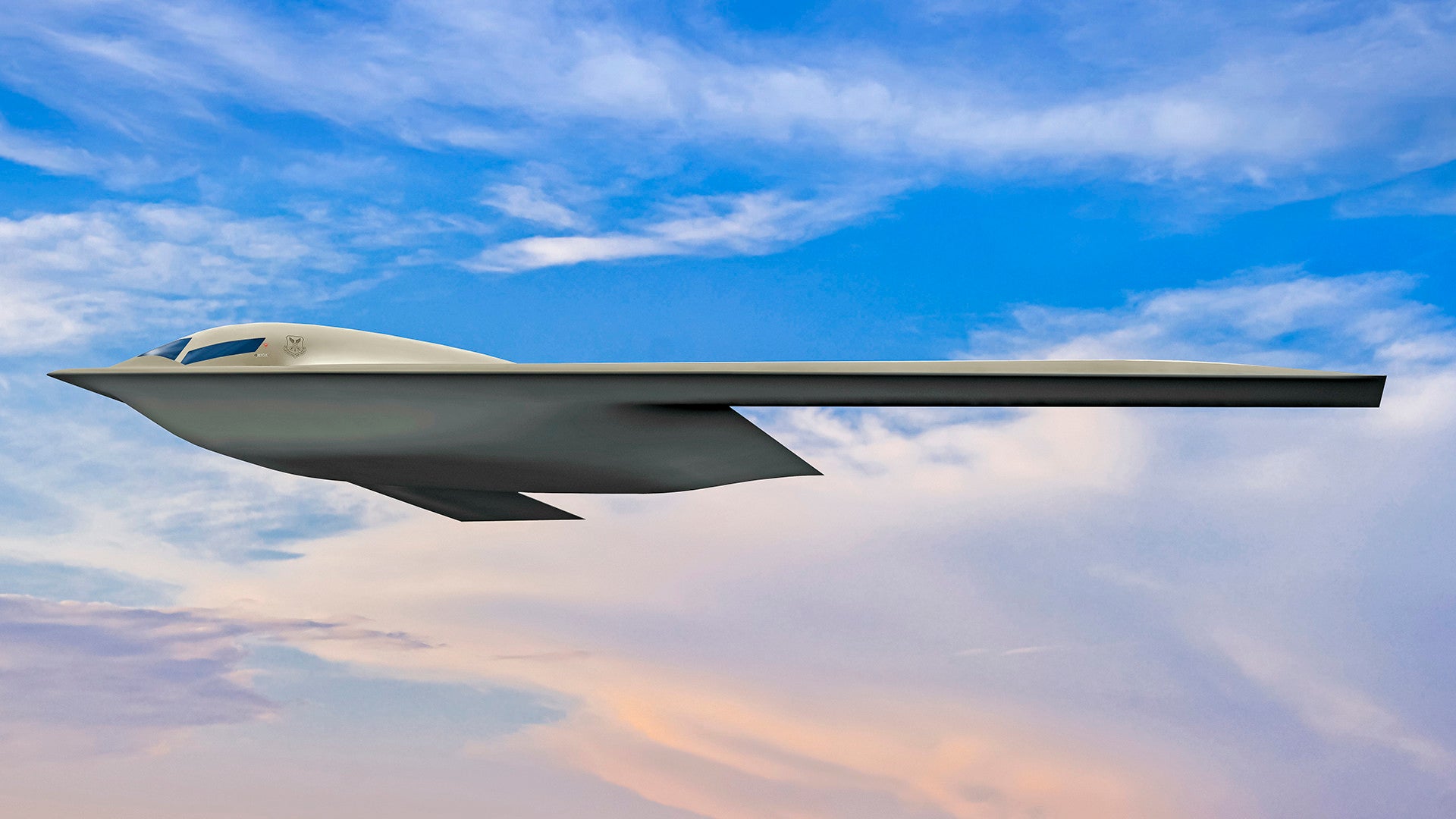The U.S. Air Force has released what is only the third official rendering of its future B-21 Raider stealth bomber, which shows a previously unseen and extremely curious cockpit windscreen configuration. The latest image depicts one of the aircraft flying over Edwards Air Force Base in California, where initial testing of these bombers is set to begin after the type’s first flight, which is presently expected to occur in May 2022.
The Air Force released the new B-21 artwork on July 6, 2021, to go along with an official online fact sheet on the Raider. The service had released the second artist’s conception of the jet in January 2020, with the same rendering of the aircraft individually depicted inside hangars at Ellsworth Air Force Base in South Dakota, Whiteman Air Force Base in Missouri, and Dyess Air Force Base in Texas. Ellsworth is expected to be the first base to host an operational B-21 squadron after the type enter service in the mid-2020s, followed by Whiteman and Dyess.

“Nuclear modernization is a top priority for the Department of Defense and the Air Force, and B-21 is key to that plan,” Randall Walden, the director of the Air Force Rapid Capabilities Office, said in a statement accompanying the artwork and fact sheet releases. “The built-in feature of open systems architecture on the B-21 makes the bomber effective as the threat environment evolves. This aircraft design approach sets the nation on the right path to ensuring America’s enduring airpower capability.”
By far the most eye-catching detail in this new rendering is the windscreen configuration, which is notably different from the ones seen in the two earlier artists’ conceptions of the B-21. The earlier art showed only a pair of cockpit windows, while the latest art shows at least one new narrow, slanted window on the left side of the cockpit. The assumption is that there is likely to be an identical one on the other side.
A closer look at the rendering also indicates that there are still two separate windscreens at the front. This would all be more in line, in general, with the four cockpit windows found on the existing B-2 Spirit stealth bomber. Northrop Grumman is the company behind both the B-2 and B-21 designs.

However, it’s not clear what purpose these windows would serve or why it would be useful for them to be shaped in this way. This downward to upward slanted shape would appear to provide almost no upward visibility and be below the pilot’s eyeline. It’s also unclear why this would’ve been the preferred design versus two windscreens that extend on either side of the cockpit, as seen in the earlier renderings. The framing in between the additional windows would only increase the number of joint areas that would have to be smoothed over, and kept immaculately that way, in order to preserve the jet’s stealth characteristics. At the same time, relatively large, single-piece curved windows are complex structures to produce.
Beyond that, the new art offers few, if any other potential substantive details. We get no additional looks at the aircraft’s stealthy inlets for its engines, or their shrouded exhausts, which are highly sensitive and especially complex features of the design. The rendering does show more of a pronounced bulge in the aircraft’s belly, which is similar, in broad respects, to the otherworldly shape of the B-2. Still, we can expect it to be more pronounced due to the aircraft’s single weapons bay and smaller payload and overall size, compared to the B-2.

The artwork does not show any significant changes to the aircraft’s general planform from the one seen in the second official rendering, which is very reminiscent of Northrop’s original high-altitude Advanced Technology Bomber design of the 1980s that preceded the final B-2 configuration. This design was later adapted to accommodate a low-level penetration capability requirement that was added mid-development by the USAF. The final design that would become the B-2 also gained the type’s trademark sawtooth trailing edge, which lowered the aircraft’s operating ceiling and degraded its stealthiness, especially from the rear aspect. You can read all about this and how the B-21’s ‘back to the future’ design will likely restore the high-altitude ambitions lost in the B-2 program, in this past special feature.
The latest B-21 rendering also notably has the same highly-pronounced, almost bill-like chine line leading edge, as opposed to the B-2’s pronounced ‘beak,’ that was seen in the second artist’s conception that the Air Force released last year. You can read our full analysis made at the time of the release of those renderings here.
It is, of course, also important to remember that this is just a rendering and may not be entirely representative of the final design. In fact, some of it could represent deliberate misdirection. Regardless, when it comes to stealth technology, it is also about the complex structures that hide beneath the outer mold line of the aircraft that play a major part in giving it its low-observable qualities, as well as its radar absorbent material (RAM) coating. In other words, there is so much more than what meets the eye.

When it comes to the information in the fact sheet, the most notable detail is the updated projected unit cost of $639 million in 2019 dollars. This is almost $673 million in today’s dollars.
In 2010, the projected unit cost of what was then referred to as the Long Range Strike-Bomber (LRS-B) was $550 million, or close to $580 million in today’s dollars. That price point also assumed the Air Force would procure at least 100 of these aircraft. The service’s current plan is to buy as many as 149 B-21s.
“Former Secretary of Defense Robert Gates directed B-21 Average Procurement Unit Cost as a key performance parameter as the best means to control costs,” the fact sheet stresses.

Beyond that, the details about the B-21 program, as well as the aircraft itself, all appear to have been previously reported.
“The B-21 Raider will be a component of a larger family of systems for conventional Long Range Strike, including Intelligence, Surveillance and Reconnaissance, electronic attack, communication and other capabilities,” the fact also states. “It will be nuclear capable and designed to accommodate manned or unmanned operations. Additionally, it will be able to employ a broad mix of stand-off and direct-attack munitions.” Both its early nuclear capability and its optionally manned concept were confirmed by The War Zone four years ago while speculation was rife that the aircraft would not have those features, at least for some time.
The larger family of systems also is thought to include the secretive RQ-180 drone, which you read more about in detail in this War Zone feature.
“The B-21 is being designed with open systems architecture to reduce integration risk and enable competition for future modernization efforts to allow for the aircraft to evolve as the threat environment changes,” it adds.
The first two B-21s are currently in different states of production at Plant 42 in California. The Air Force hopes to publicly roll out the first of them sometime early next year.
When that happens, it will be very interesting to see how the renderings we’ve seen so far, and any that are still to come, line up with the Raider’s actual design.
Update:
The idea of having no windscreen at all for a stealthy aircraft has been a possibility for some time, especially when it comes to the very cutting-edge B-21. You can read my whole thread about this possibility, and why I think it is unlikely, here or by clicking through the tweet below:
Contact the author: joe@thedrive.com
